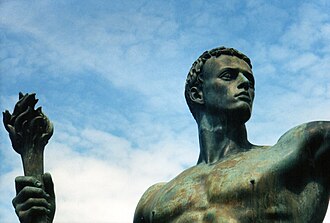Master race

Master race is an idea that one group of people is better than everybody else because of their race.
The idea first appeared in the 19th century. It was a key part of Nazi ideology during World War II and the Holocaust. It was also central to the Jim Crow laws in the United States, apartheid in South Africa, the White Australia policy and the Indian Act in Canada.
Claims
The idea claims there is a hierarchy of races (that some races are better than others).
Scientists today do not support this theory and such claims.
Development
Early ideas
Arthur de Gobineau first developed the idea of the Aryan master race in his book Essay on the Inequality of the Human Races (French: [Essai sir l’inégalité des races humaines] Error: {{Lang}}: text has italic markup (help)). The book was published in four volumes between 1853 and 1855. In it, de Gobineau wrote that people of different races were not equal, and that the white race was superior. He thought that major cultures and civilizations had declined because people of different races mixed.
His work was an early example of scientific racism.
Social Darwinism
In 1859, Charles Darwin published his theory of evolution. Social Darwinists applied his theories about the "survival of the fittest" to human society. They believed that the stronger races would prove themselves better in the long run.
Houston Steward Chamberlain was one well-known Social Darwinist. He wrote several popular books claiming that Aryans were the master race. In his view, the world's greatest achievements had all been the work of Aryans. He thought the Germanic race existed "to save the world," and that without Aryans, civilization would collapse.[1]
In colonialism
The idea of the master race was central to colonialism.
Germany and Great Britain had many colonies. They would pick an ethnic group and say that this was better than the other groups. This would then lead to an indirect rule in the respective colony. People who conducted African studies in Germany developed a whole system, to make this easier. The Hamitic theory said that the Hamitic people were superior and should rule over the other Black people people in Sub-Saharan Africa. John Hanning Speke (1827-64) and Charles Gabriel Seligman (1873-1940) were among the most prominent people with this idea. People such Johann Ludwig Krapf, Karl Richard Lepsius, or Carl Meinhof used the study of languages in this context. They said that languages that had a grammatical genus were Hamitic, those that did not were Negroid. Using these criteria to find suitable candidates for indirect rule also led to problems: According to the theory, the Maasai were Hamitic, and should rule in German East Africa. Fortunately, they were unable to make such a system for political and economic reasons. The explanation was that "out of bad luck", the Maasai were a Hamitic people kept at a lower level of social development. In their place, the Swahili were picked, as the "next-higher" people. In German South-West Africa, there was a similar problem: The theory identified the Khoikhoi as Hamitic, but they were too few to rule the country. For this reason, the Ovambo were picked for an indirect rule.
Arthur Schopenhauer liked this idea, but had the idea of "Übermensch": He said that the White race had become what it was though hardship and bad conditions in the North. Others who liked his theory were Guido von List and Lanz von Liebenfels.
In World War II
The idea of a "master race" was central to World War II and the Holocaust.
In 1933 Adolf Hitler's Nazi Party took power in Germany. The Nazis were Social Darwinists.[2] They claimed that "Aryans" were the "master race" and would someday rule over the weaker races.
The Nazis made laws based on their ideas about race. They prevented marriage between races, because they thought the "master race" would be weakened if Aryans mixed with non-Aryans.
They also made propaganda that blamed Jews and their religion, Judaism for many things. Jews was considered by Nazis, a weak race with a weak religion which its weak values would infect the better values of the Aryan race. German Jews were not allowed to own property. In many cases, they were attacked and killed because of their Race and Religion. When Germany invaded other countries in Europe, they also started putting people into death camps. This systematic killing is known as The Holocaust today.
To help increase the numbers of Aryans, the Nazis set up special homes called "Lebensborn".[3] These were for unmarried pregnant woman who were likely to have children that had Aryan qualities.[3] This mainly meant fair skin, blond hair, blue eyes. Though slight differences could still be considered Aryan as lots of people in Germany at the time had dark hair and eyes. Heinrich Himmler believed that this would help create more members of the master race. He arranged for nine Lebensborn homes to be built in Germany, and another ten in Norway.[3] There were also Lebensborn in France, Belgium and Luxembourg. About 20,000 children were born in these homes during the Third Reich.[3]
Master Race Media
German warning in Nazi-occupied Poland 1939 – "No entrance for Poles!"
Werner Goldberg, who was part Jewish but blond and blue-eyed, was used in Nazi recruitment posters as "The Ideal German Soldier."
Related pages
References
- ↑ Field, Geoffrey G. (1981). Evangelist of race: the Germanic vision of Houston Stewart Chamberlain. New York: Columbia University Press. ISBN 978-0-231-04860-6.
- ↑ "Adolf Hitler". jewishvirtuallibrary.org. Retrieved May 25, 2010.
- ↑ 3.0 3.1 3.2 3.3 Hammer, Joshua (2000). "Hitler's Children". Newsweek. 135 (12): 44.

